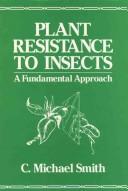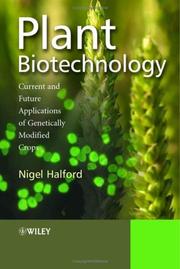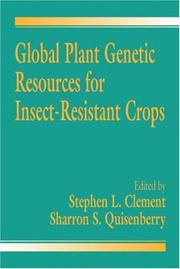| Listing 1 - 10 of 39 | << page >> |
Sort by
|
Dissertation
ISBN: 9789088262166 Year: 2011 Volume: 998 Publisher: Leuven Katholieke Universiteit Leuven
Abstract | Keywords | Export | Availability | Bookmark
 Loading...
Loading...Choose an application
- Reference Manager
- EndNote
- RefWorks (Direct export to RefWorks)
The burrowing nematode, Radopholus similis (Cobb, 1893) Thorne, 1949 is considered as the most damaging nematode species in commercial banana plantations. Nematicides have been intensively used to control plant-parasitic nematodes. However, many effective nematicides have been withdrawn from the market due to their adverse effects on the environment, non-target organisms and the accumulation of toxic residues in the food chain. The use of resistant cultivars is an efficient and economical alternative approach for controlling nematode populations. Unraveling the mode(s) of action or gaining in-depth knowledge on the mechanism(s) of host resistance to a nematode may provide information that can be used either to improve the efficacy of the use of the resistance or to assist in the faster selection or breeding of resistant cultivars. The main objective of our study was to characterise the mechanism(s) of resistance to R. similis in Musa spp. To achieve this objective, seven newly reported R. similis-resistant Musa genotypes were selected and their response to R. similis infection was verified under greenhouse conditions. The host responses were compared with the well-known R. similis-resistant reference cultivars Yangambi km5, Pisang Jari Buaya and the susceptible cultivar Grande Naine. The host response of these Musa genotypes to the root-knot nematode Meloidogyne incognita (Kofoid and White, 1919) Chitwood, 1949 infection was also evaluated to examine if the R. similis-resistant genotypes are also resistant to M. incognita. Four Musa genotypes Long Tavoy, Saba, Pisang Mas and Pora Pora expressed resistance to R. similis. Marau expressed a partial resistance to R. similis. The host response of Kokopo was inconclusive and Gia Hui was susceptible to R. similis. We consider the use of tissue culture-derived plants and highly pathogenic population of R. similis as the reasons for susceptibility of the previously reported R. similis-resistant genotype Gia Hui. For the first time, Vudu Papau and Pisang Mas were identified as resistant to M. incognita based on the final nematode population density. Pisang Mas is identified as a Musa genotype with combined resistance to both R. similis and M. incognita. This is the first time that a Musa genotype has been found as resistant to these two major banana root pathogens. Three R. similis resistant Musa genotypes Long Tavoy, Saba and Yangambi km5 were shortlisted for characterization of R. similis resistance in comparison with the susceptible reference cultivar Grande Naine. Our first major specific objective was to find out at which phase of the nematode-plant interactions (i.e. pre- or post-infection) the resistance to R. similis was active in the Musa genotypes. To achieve this specific objective, an autotrophic in vitro model system was developed to compare R. similis attraction, migration towards and penetration of the R. similis-resistant and susceptible Musa genotypes. A novel two-compartment system was developed to examine the attraction of R. similis to either Grande Naine or Yangambi km5 when both Musa genotypes were present.Plant root growth in the autotrophic in vitro system was good with well-developed secondary and tertiary roots. The autotrophic in vitro system was an advantageous model system to study nematode attraction towards and penetration in the roots of banana. This include good plant and root growth in the autotrophic system and ability to observe the living plant roots under microscope without compromising the easy handling, short duration and aseptic conditions of strict in vitro model systems. No significant differences were observed in the percentage of R. similis migrated towards the roots of the Grande Naine (susceptible) and Yangambi km5 (resistant) at 3, 4 and 6 h after inoculation. The percentages of females that had penetrated the roots of Yangambi km5 and Grande Naine were not significantly different from each other at 1 and 2 days after inoculation. The results of the two-compartment system showed no significant differences in the percentage of R. similis females migrated towards the roots of resistant and susceptible genotypes when they could access both roots at the same time. Hence, R. similis females showed no preference to migrate towards the roots of either the resistant or susceptible Musa genotype when a choice was given. Two greenhouse experiments were conducted on the penetration, development and reproduction of R. similis on three resistant (Long Tavoy, Saba and Yangambi km5) and one susceptible (Grande Naine) Musa genotypes. Radopholus similis penetration rate was checked at 4, 8 and 12 days after inoculation. The nematode development and reproduction were checked at 26 days after inoculation. No significant differences were observed between the numbers of nematodes that had penetrated the four Musa genotypes at 4 and 8 days after inoculation. Eggs were observed in Grande Naine but not in any of the three resistant Musa genotypes at 8 days after inoculation. Significantly lower number of eggs was observed in the roots of a resistant genotype Long Tavoy at 12 days compared to Grande Naine. The number of eggs, males, females, number of adults and juveniles and final population density were significantly higher in the susceptible genotype Grande Naine compared to the three R. similis-resistant Musa genotypes at 26 days after inoculation. The post-infectional nematode development and reproduction were severely impaired in the resistant Musa genotypes. Hence, it appears that the mechanism of resistance in the investigated Musa genotypes to R. similis is induced after nematode penetration and that preformed host resistance factors do not function strongly against the nematode attraction and migration towards the roots, and penetration of the roots. The second major specific objective of our study was to identify the phytochemicals involved in the resistance to R. similis in the resistant Musa genotypes. A preliminary phytochemical profiling was performed to assess the involvement of lignin and phenols in the resistance of the three R. similis-resistant Musa genotypes in comparison with Grande Naine. The uninfected plants of all Musa genotypes sampled at 6 weeks after inoculation showed intenselignifications in their vascular bundle compared to the plants sampled at 3 weeks after infection. This showed that the older roots are more extensively lignified in the secondary cell walls than the younger roots. Nematode infection has significantly increased the lignin content of Yangambi km5 roots at 6 weeks after inoculation. In all four Musa genotypes, lignification started at the endodermis, extended to the peripheral tissues of vascular system especially the xylem walls, xylem-accompanying parenchyma cells and eventually progress to the vascular parenchyma (sclerenchyma) cells in the centre. The cortex and aerenchyma cells were lignified to a very small extent. Extensive lignification is not associated with the cortex cells that are directly involved in the defense to R. similis. This shows that the increased lignification is only a general defense response to protect the vascular bundle to reduce damage to the plants. Hence it appears that the lignification is more associated with the plant’s tolerance to R. similis preventing damage to the plants than resistance to nematode development, reproduction and multiplication. Histochemical localisation of total phenols by staining with toluidine blue showed no preformed phenolic cells in the cortex of the R. similis-resistant and susceptible Musa genotypes. Phenolic substances were major constituents of the nematode infected necrotic cells. The Folin-Ciocalteu assay showed that the nematode infection has almost doubled the total phenols contents in all Musa genotypes at 3 weeks after infection and in the resistant genotypes at 6 weeks after inoculation. The enhanced synthesis of phenols could be due to the biosynthesis or accumulation of secondary metabolites such as phytoalexins in the nematode infection sites. In the final part of characterizing the nematode resistance in Musa genotypes, a combination of analytical techniques namely high performance liquid chromatography (HPLC), Proton nuclear magnetic resonance spectroscopy (1H NMR) and ultra performance liquid chromatography coupled with mass spectrometry (UPLC-MS) was used to identify the secondary metabolites that are induced in nematode infection sites. The secondary metabolites were localised to study their distribution using matrix-free laser desorption/ionisation mass spectrometric imaging (LDI-MSI) techniques. The HPLC and 1H NMR analysis structurally identified nine phenylphenalenone-type phytoalexins and the UPLC-MS analysis identified one additional phenylphenalenone-type phytoalexin from R. similis-infected necrotic tissues of the banana roots. Our results provided clear evidence for the induction of phenylphenalenone-type secondary metabolites in Musa spp. in response to R. similis infection. These compounds were absent in the uninfected control roots. The phenylphenalenones showed a highly localised presence only in the nematode-infected necrotic regions of the banana roots. Observation of the lesions also showed that, in Yangambi km5, the lesions are small, discontinuous and non-expanding as in hypersensitive lesions. But, in Grande Naine, the lesions were large, tunnel-like and covered larger areas of the infected roots. Anigorufone was identified as the most abundant phenylphenalenone-type secondary metabolite present in the necrotic lesions of R. similis-resistant and susceptible cultivars. But, the concentration of anigorufone per unit area was very high in Yangambi km5 compared to Grande Naine. The higher concentration of anigorufone and other phenylphenalenone-type phytoalexins localised in few cells in the R. similis-resistant cultivar can create a more toxic cellular environment to the nematode compared to Grande Naine.The anti-nematode properties of the identified phenylphenalenones were assessed by in vitro bio-assays on nematode motility inhibition and nematode mortality. Eleven out of thirteen testedphenylphenalenones were inhibitive to R. similis motility. Our results are the first evidence for the anti-nematode properties of phenylphenalenones. Anigorufone, 4-hydroxy-2-methoxy-9-phenylphenalenone and isoanigorufone were remarkably powerful anti-nematode compounds tested in our study in that they caused quiescence to more than 75% of R. similis juveniles and adults. Hydroxyanigorufone and monohydroxyanigorootin were also highly inhibitive to R. similis motility starting from 24 h of incubation and the effect was either consistent or increased over time. Anigorufone was the most powerful anti-nematode compound assayed. The motility inhibition concentration of anigorufone required to cause quiescence to 50% of the tested R. similis (IC50) was only 23 ppm at 72 h of incubation. At higher concentrations of anigorufone such as 50, 100 and 150ppm, nematodes ingested large amounts of the compound causing mortality of the nematodes. The ingested anigorufone was found accumulated in the nematode guts of all life stages of nematodes. Elaborated future bio-assaysusing different combination of the identified compounds will enhance the understanding on the synergism or antagonism of the compounds. Future studies could explore the possibilities of enhancing the cellular concentration and improved localisation of anigorufone and other phenylphenalenones in the roots of R. similis-susceptible commercially successful banana cultivars such as Grande Naine.
Germplasm --- Musa --- Radopholus similis --- Résistance aux organismes nuisibles --- Pest resistance --- Relation hôte parasite --- Host parasite relations --- Academic collection --- Theses
Book
ISSN: 00976156 ISBN: 0841209502 9780841209503 Year: 1986 Volume: 296 Publisher: Washington, DC: American chemical society,
Abstract | Keywords | Export | Availability | Bookmark
 Loading...
Loading...Choose an application
- Reference Manager
- EndNote
- RefWorks (Direct export to RefWorks)
Allelopathic agents --- Pests --- Insect-plant relationships --- Congresses --- Biological control --- Plante --- plants --- Insecte nuisible --- Pest insects --- Résistance aux organismes nuisibles --- Pest resistance --- Composition chimique --- Chemical composition --- Substance sémiochimique --- Semiochemicals --- Allelopathic agents - Congresses --- Pests - Biological control - Congresses --- Insect-plant relationships - Congresses

ISBN: 0471849383 9780471849384 Year: 1989 Publisher: New York (N.Y.): Wiley,
Abstract | Keywords | Export | Availability | Bookmark
 Loading...
Loading...Choose an application
- Reference Manager
- EndNote
- RefWorks (Direct export to RefWorks)
Plants --- Insect resistance. --- Plante --- plants --- Résistance aux organismes nuisibles --- Pest resistance --- Insecta --- Mécanisme de défense --- Defence mechanisms --- Tolérance --- Tolerance --- Insect resistance --- Plants - Insect resistance. --- Disease and pest resistance --- Tolerance. --- Plants - Insect resistance --- Plants - Disease and pest resistance --- Antibiose
Book
ISBN: 9782759203499 Year: 2009 Publisher: Versailles : QUAE,
Abstract | Keywords | Export | Availability | Bookmark
 Loading...
Loading...Choose an application
- Reference Manager
- EndNote
- RefWorks (Direct export to RefWorks)
Forêt tropicale --- Tropical forests --- Bois --- Wood --- Insecte xylophage --- Timber boring insects --- Résistance aux organismes nuisibles --- Pest resistance --- Préservation du bois --- wood preservation --- Environmental Sciences and Forestry. Forestry -- Forest Ecology -- Ecology of Tropical Forests --- ALLW.

ISBN: 0470021810 9780470021811 Year: 2006 Publisher: Hoboken, N.J. Wiley
Abstract | Keywords | Export | Availability | Bookmark
 Loading...
Loading...Choose an application
- Reference Manager
- EndNote
- RefWorks (Direct export to RefWorks)
*Plant Biotechnology: Current and Future Uses of Genetically Modified Crops* covers in detail the development, use and regulation of GM crops. Split into three sections, Part 1 introduces GM crops and describes the GM crops that are used commercially. Part 2 looks at new developments and methodologies in areas including potential applications of GM crops for the production of vaccines, enhanced nutritional value of GM food, and engineering resistance to fungal pathogens. Part 3 concludes by considering the key issues of safety and legislation, including allergenicity, environmental impacts, risk assessment and labelling. **Key features:** - Covers the topic in depth and addresses key subject areas - Takes a broad view of the current situation in different countries - Examines the commercial application of plant biotechnology in the USA and China - Covers two major areas of public concern: allergenicity and gene flow - Covers new developments in plant research, safety and legislation aspects
biotechnologie --- planten --- genetische manipulatie --- Biotechnology --- Plante de culture --- Crops --- Plante transgénique --- Transgenic plants --- Génie génétique --- genetic engineering --- Méthode d'amélioration génétique --- breeding methods --- Paramètre génétique --- genetic parameters --- Résistance aux maladies --- Disease resistance --- Résistance aux organismes nuisibles --- Pest resistance --- Amélioration de qualités nutritives --- nutrient improvement --- Planten : genetische manipulatie --- Planten : genetica --- Biotechnologie --- 581.16 --- allergieën --- Plant biotechnology --- Crop biotechnology --- Plants --- Agricultural biotechnology --- vaccinatie --- vetzuren
Book
ISBN: 0306347105 1468426486 146842646X 9780306347108 Year: 1976 Volume: v. 10 Publisher: New York Plenum Press
Abstract | Keywords | Export | Availability | Bookmark
 Loading...
Loading...Choose an application
- Reference Manager
- EndNote
- RefWorks (Direct export to RefWorks)
Insects. Springtails --- Phytochemistry. Phytobiochemistry --- Animal biochemistry --- Botanical chemistry --- Insect-plant relationships --- Chimie végétale --- Congresses --- Congrès --- Plante --- plants --- Insecte nuisible --- Pest insects --- Résistance aux organismes nuisibles --- Pest resistance --- Composition chimique --- Chemical composition --- Compétition biologique --- Biological competition --- Chimie végétale --- Congrès --- Botanical chemistry - Congresses --- Insect-plant relationships - Congresses --- Insect --- Plant
Book
ISBN: 0306411830 1461593077 1461593050 Year: 1983 Volume: vol 55 Publisher: New York London Plenum Press
Abstract | Keywords | Export | Availability | Bookmark
 Loading...
Loading...Choose an application
- Reference Manager
- EndNote
- RefWorks (Direct export to RefWorks)
Résistance aux maladies --- Disease resistance --- Plante de culture --- Crops --- Résistance aux organismes nuisibles --- Pest resistance --- Amélioration des plantes --- Plant breeding --- Plants --- Plant and Crop Sciences. Plant Breeding and Genetics --- Congresses. --- Disease and pest resistance --- Genetic aspects --- Resistance Breeding --- Resistance Breeding. --- Selection (Plant breeding) --- Congresses --- Planten. Weerstand aan ziekten. (Congres) --- Plantes. Résistance aux maladies et aux fléaux. (Congrès) --- Plantes. Sélection. (Congrès) --- Selectie van planten. (Congres)

ISBN: 0849326958 9780429117855 042911785X 9780429525391 0429525397 9781420049336 142004933X 9780429540097 0429540094 9780849326950 Year: 1998 Publisher: Boca Raton, Fla Boston London CRC Press
Abstract | Keywords | Export | Availability | Bookmark
 Loading...
Loading...Choose an application
- Reference Manager
- EndNote
- RefWorks (Direct export to RefWorks)
Oryza --- Triticum --- Phaseolus --- Sorghum --- Légumineuse à grains --- Grain legumes --- Medicago sativa --- Vegetables --- Ipomoea batatas --- Solanum tuberosum --- Résistance aux organismes nuisibles --- Pest resistance --- Code génétique --- genetic code --- Germplasm --- Biodiversité --- Biodiversity --- Génie génétique --- genetic engineering --- Biotechnologie végétale --- Plant biotechnology --- Food crops --- Plasma germinatif --- Insect resistance --- Genetic aspects --- Food crops - Insect resistance - Genetic aspects.
Dissertation
ISBN: 9789059892545 Year: 2008 Publisher: Gent Universiteit Gent. Faculteit Bio-Ingenieurswetenschappen
Abstract | Keywords | Export | Availability | Bookmark
 Loading...
Loading...Choose an application
- Reference Manager
- EndNote
- RefWorks (Direct export to RefWorks)
Allium sativum --- Plante transgénique --- Transgenic plants --- Spodoptera littoralis --- Résistance aux organismes nuisibles --- Pest resistance --- Biopesticide --- Biopesticides --- Lectine --- lectins --- Myzus nicotianae --- Acyrthosiphon pisum --- Spodoptera frugiperda --- Manduca sexta --- Ferritine --- Ferritin --- Propriété des pesticides --- pesticidal properties --- 577.112.853 --- 632.951 --- Mucoproteins (glycoproteins). Lectins --- Preparations for destruction of arthropods and molluscs. Insecticides. Acaricides. Molluscicides --- Theses --- 632.951 Preparations for destruction of arthropods and molluscs. Insecticides. Acaricides. Molluscicides
Book
ISBN: 2225794979 9782225794971 Year: 1983 Publisher: Paris: Masson,
Abstract | Keywords | Export | Availability | Bookmark
 Loading...
Loading...Choose an application
- Reference Manager
- EndNote
- RefWorks (Direct export to RefWorks)
Ecology --- Ecologie --- Écologie --- ecology --- Climat --- climate --- Bilan énergétique --- Energy balance --- Niveau trophique --- Trophic levels --- Cycle biogéochimique --- cycling --- Écosystème --- ecosystems --- Conservation des ressources --- Resource conservation --- Production alimentaire --- Food production --- Agriculture --- agriculture --- Résistance aux organismes nuisibles --- Pest resistance --- Biotechnologie --- Biotechnology --- agriculture. --- Population dynamics
| Listing 1 - 10 of 39 | << page >> |
Sort by
|

 Search
Search Feedback
Feedback About UniCat
About UniCat  Help
Help News
News